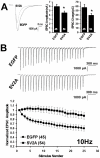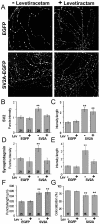Levetiracetam reverses synaptic deficits produced by overexpression of SV2A
- PMID: 22220214
- PMCID: PMC3248421
- DOI: 10.1371/journal.pone.0029560
Levetiracetam reverses synaptic deficits produced by overexpression of SV2A
Abstract
Levetiracetam is an FDA-approved drug used to treat epilepsy and other disorders of the nervous system. Although it is known that levetiracetam binds the synaptic vesicle protein SV2A, how drug binding affects synaptic functioning remains unknown. Here we report that levetiracetam reverses the effects of excess SV2A in autaptic hippocampal neurons. Expression of an SV2A-EGFP fusion protein produced a ∼1.5-fold increase in synaptic levels of SV2, and resulted in reduced synaptic release probability. The overexpression phenotype parallels that seen in neurons from SV2 knockout mice, which experience severe seizures. Overexpression of SV2A also increased synaptic levels of the calcium-sensor protein synaptotagmin, an SV2-binding protein whose stability and trafficking are regulated by SV2. Treatment with levetiracetam rescued normal neurotransmission and restored normal levels of SV2 and synaptotagmin at the synapse. These results indicate that changes in SV2 expression in either direction impact neurotransmission, and suggest that levetiracetam may modulate SV2 protein interactions.
Conflict of interest statement
Figures





References
-
- Kinrys G, Worthington JJ, Wygant L, Nery F, Reese H, et al. Levetiracetam as adjunctive therapy for refractory anxiety disorders. J Clin Psychiatry. 2007;68:1010–1013. - PubMed
-
- Kinrys G, Wygant LE, Pardo TB, Melo M. Levetiracetam for treatment-refractory posttraumatic stress disorder. J Clin Psychiatry. 2006;67:211–214. - PubMed
-
- Zhang W, Connor KM, Davidson JR. Levetiracetam in social phobia: a placebo controlled pilot study. J Psychopharmacol. 2005;19:551–553. - PubMed
-
- Enggaard TP, Klitgaard NA, Sindrup SH. Specific effect of levetiracetam in experimental human pain models. Eur J Pain. 2006;10:193–198. - PubMed
Publication types
MeSH terms
Substances
Grants and funding
LinkOut - more resources
Full Text Sources
Other Literature Sources

